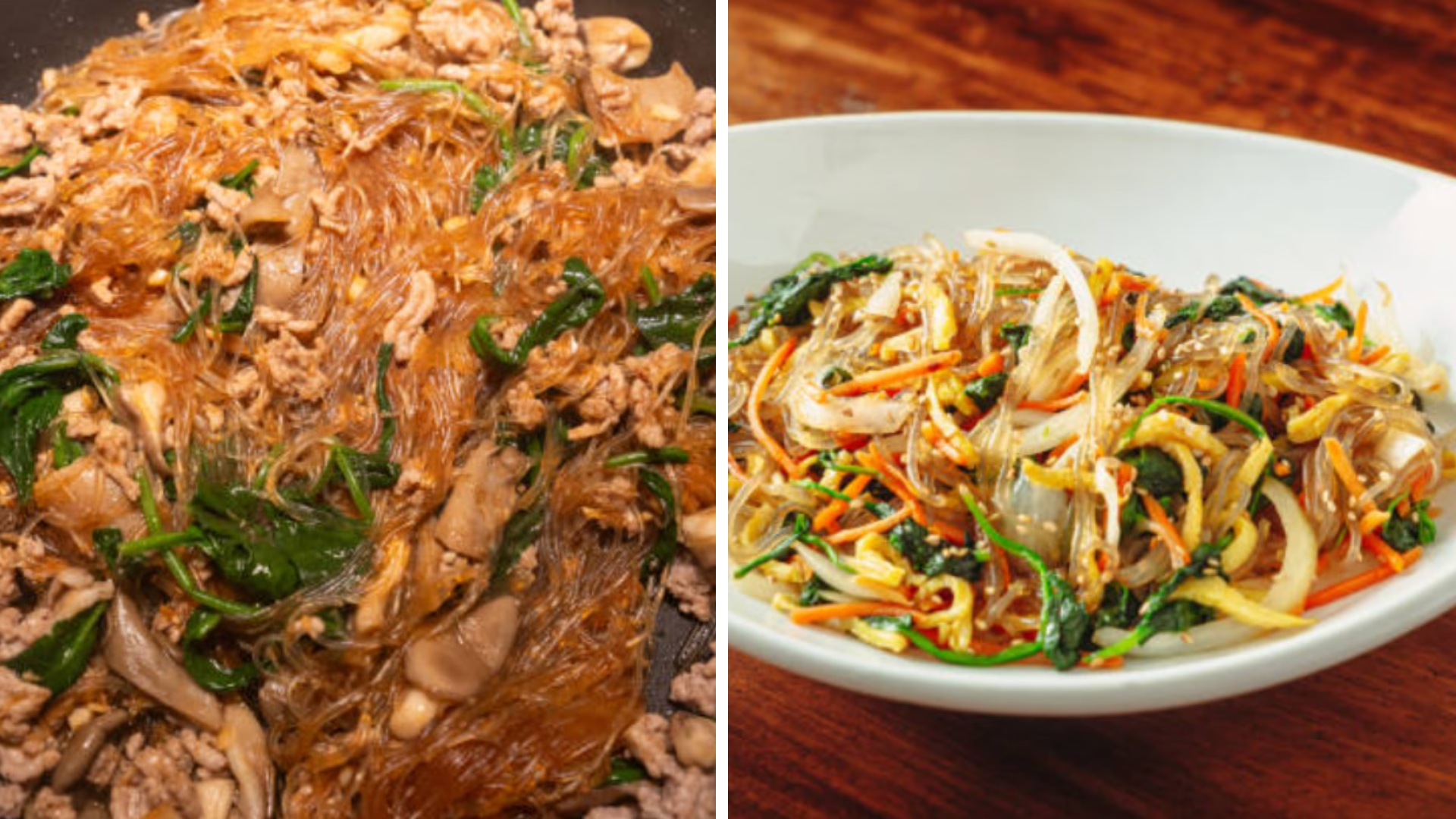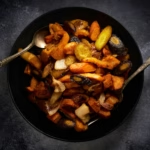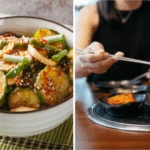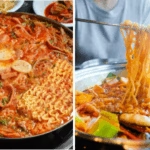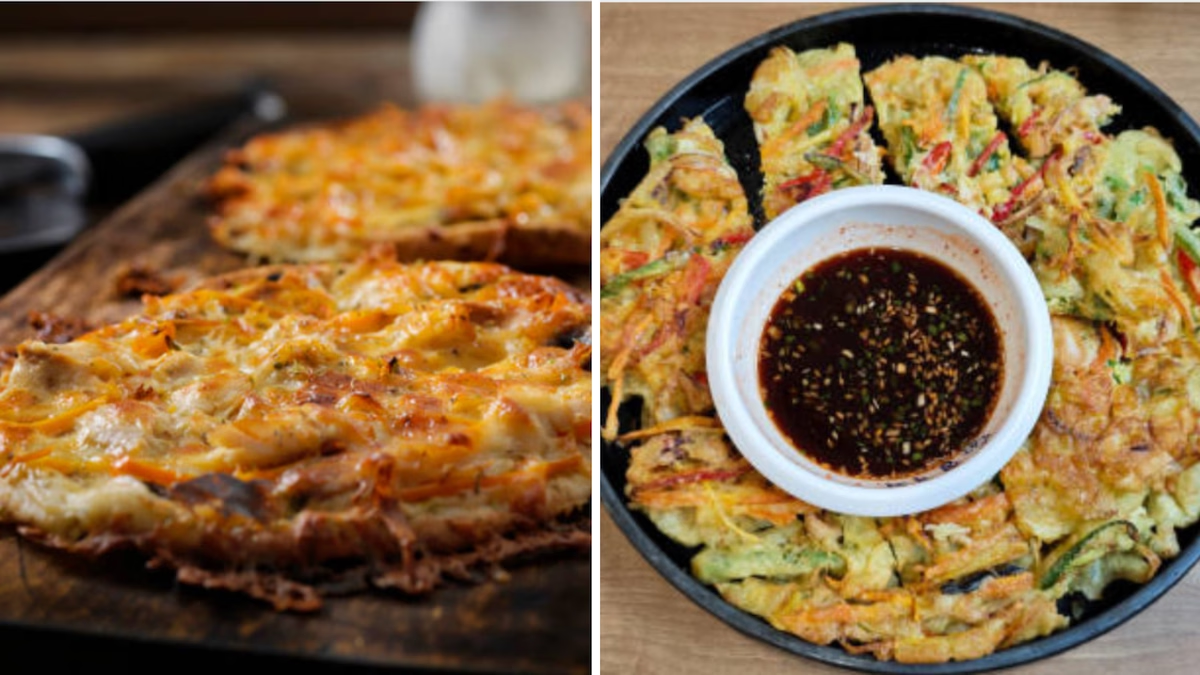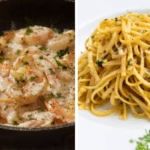In this blog you will find:
I. Introduction: Japchae Unlocked
Imagine this: sweet-savory glass noodles tangled with vibrant veggies, kissed by sesame oil, and tossed with tender beef—or chicken, in our case. This is japchae (잡채), Korea’s beloved stir-fried noodle dish. It’s the star of birthdays, weddings, holidays, and honestly, every Korean potluck ever. But traditionally, this dish requires dangmyeon (sweet potato starch noodles), 10+ ingredients, and lots of chopping and timing finesse.
What if you could capture that magic in just 30 minutes—using ingredients from your local Walmart?
That’s what we’re serving up here.
7 pantry-friendly swaps (skip the specialty store)
One-skillet simplicity (hello, weeknight dinners!)
Authentic japchae flavours with a clever fusion twist
Tag @theworldspalette_ in your japchae creations and enter our #JapchaeHack Giveaway below!
II. What Is Japchae? More Than Just “Korean Glass Noodles”
If you’ve ever been to a Korean celebration, you’ve probably seen a shimmering platter of japchae noodles. But what exactly is it?
A Dish With Royal Roots:
Japchae was first created in the 17th century for a royal banquet thrown by King Gwanghaegun. The dish was so well-loved, it became a mainstay in the royal court.
Modern-Day Icon:
Today, japchae is Korea’s most popular party dish, served at everything from birthdays to New Year’s feasts. In fact, The Seoul Times ranked it as Korea’s #1 celebration food.
Key Elements of a Classic Japchae Recipe:
- Noodles: Dangmyeon (chewy, translucent sweet potato starch noodles)
- Sauce: Soy sauce, sesame oil, and sugar (sweet-savory umami perfection)
- Ingredients: Stir-fried vegetables like spinach, carrots, mushrooms, and a protein like beef or chicken
III. Why This 7-Ingredient Hack Beats Tradition
| Traditional Japchae Recipe | Our Japchae Hack | Why It Works |
|---|---|---|
| Dangmyeon noodles (hard to find) | Whole wheat spaghetti | Chewy, holds sauce better, cooks fast |
| 10+ fresh ingredients | 7 pantry staples | Cuts time and cost |
| 1+ hour prep time | 30 minutes total | Ice-bath trick keeps noodles bouncy |
| Specialty sauces | Soy sauce + maple syrup | Sweet-savory combo, no rice syrup needed |
Taste Test Approved:
“The spaghetti version? 90% as good—and twice as fast!”
— Kim Soo-min, Busan home cook now living in Dallas
IV. The 7-Ingredient Swap Guide
Here’s how to hack traditional japchae ingredients with easy American grocery swaps:
- Noodles: Whole Wheat Spaghetti → Dangmyeon
Why it works: Neutral flavor, great chew, easy to find.
Pro Tip: Boil 8 mins → ice bath → drain. Ice bath = no mush! - Protein: Rotisserie Chicken → Beef
Why it works: Already cooked = 10-minute shortcut.
How to: Shred 1.5 cups and sauté in soy sauce for flavor. - Mushrooms: White Button → Shiitake
Why it works: Earthy taste that mimics traditional mushrooms.
Pro Tip: Sauté until golden in olive oil. - Sweetener: Maple Syrup → Korean Rice Syrup or Honey
Why it works: Easy sweet-savory glaze.
Ratio: 2 tbsp maple syrup + ¼ cup soy sauce = perfect balance. - Veggies: Frozen Stir-Fry Mix → Fresh Carrots & Spinach
Why it works: No chopping, same color and crunch.
How to: Sauté for 5 minutes with garlic powder. - Oil: Olive Oil → Sesame Oil
Hack: Mix 1 tbsp olive oil + 1 tsp sesame seeds to mimic flavor. - Aromatics: Garlic Powder → Fresh Garlic
Conversion: 1 tbsp powder = 4 minced garlic cloves.
V. 30-Minute Japchae Recipe
Tools:
Large skillet, colander, tongs
Servings:
4 hearty portions
A. Japchae Sauce Prep (3 Minutes)
Whisk together:
- ¼ cup soy sauce
- 2 tbsp maple syrup
- 1 tbsp garlic powder (or 4 minced cloves)
- 1 tsp black pepper
B. Step-by-Step Instructions:
Step 1: Boil Your Noodles Like a Pro

Bring a large pot of water to a rolling boil. Add a generous pinch of salt, then toss in the spaghetti.
Cook for 8 minutes, stirring occasionally to prevent sticking.
Once the noodles are just al dente (not mushy!), immediately drain them and place them in a large bowl of ice water. This ice bath shocks the noodles—stopping the cooking process and helping maintain that signature japchae chew.
Let them cool for 3 minutes, then drain thoroughly and set aside.
Pro Tip: Drizzle a tiny bit of olive oil over the cooled noodles and toss gently—this prevents clumping and keeps them springy.
Step 2: Prep the Sauce

In a small bowl, whisk together the soy sauce, maple syrup, garlic powder (or minced garlic), and black pepper.
Set aside—this is the magic sauce that ties everything together with a bold, sweet-savory punch.
Step 3: Sauté the Veggies
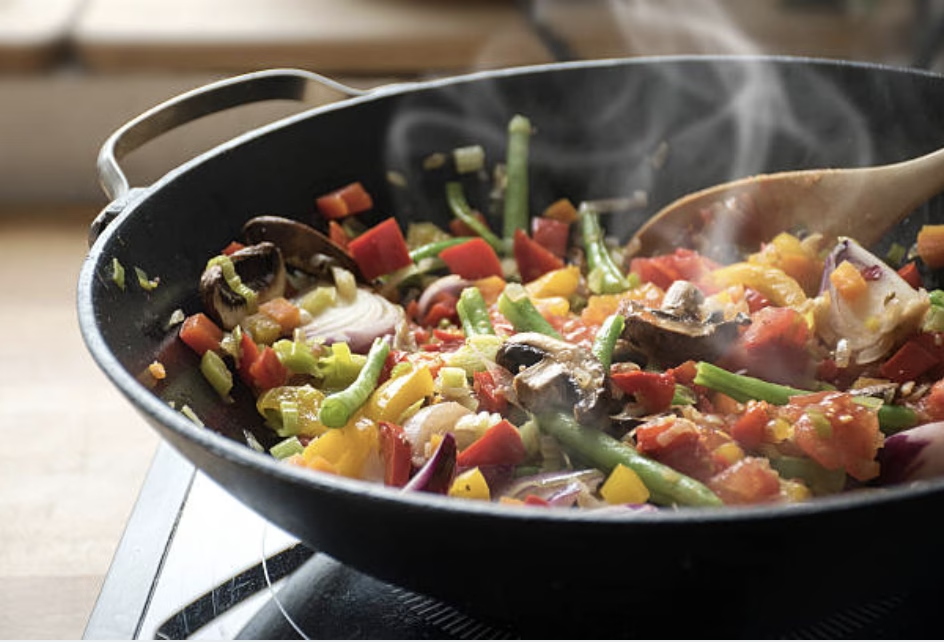
In a large skillet or wok, heat 1 tablespoon of olive oil over medium-high heat.
Once shimmering, add your frozen veggie mix straight from the bag. Sauté for 5–6 minutes, stirring occasionally, until the vegetables are cooked through but still vibrant in color.
If using fresh vegetables, slice thinly and sauté just until tender-crisp (4–5 minutes).
Optional Boost: Throw in ½ teaspoon of sesame seeds or a splash of sesame oil at this stage for extra nutty flavor.
Step 4: Add the Chicken
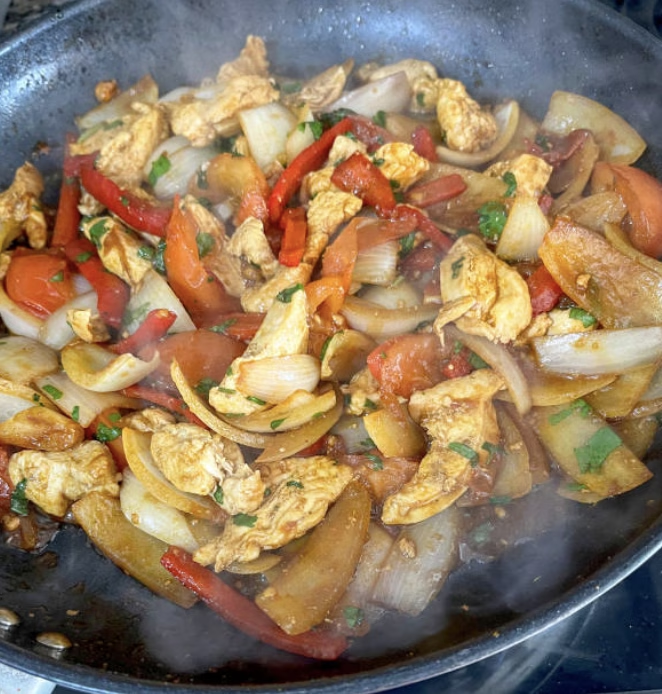
Add the shredded rotisserie chicken to the skillet with the cooked veggies.
Stir-fry together for 2–3 minutes, just until the chicken is heated through and lightly browned in spots.
If your chicken is plain, you can splash in 1 tablespoon of soy sauce for extra flavor.
Step 5: Bring It All Together
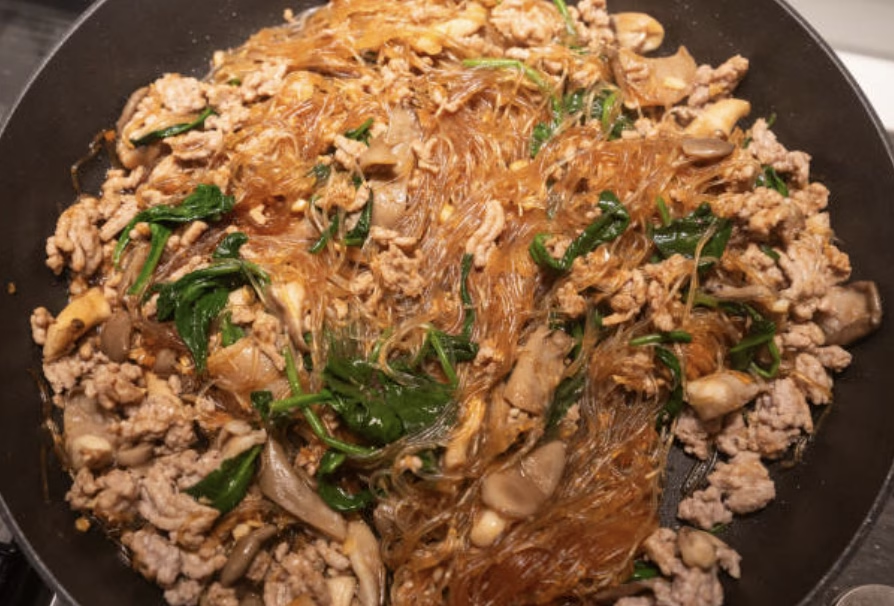
Add the cooled, drained spaghetti noodles into the skillet. Use tongs to toss everything together—noodles, veggies, and chicken.
Pour the japchae sauce evenly over the top and toss again, gently but thoroughly, for 3–5 minutes over medium heat until everything is hot, glossy, and evenly coated.
If your skillet feels crowded, do this in two batches to avoid breaking the noodles.
Step 6: Garnish & Serve

Turn off the heat and transfer your japchae to a serving platter or individual bowls.
Top with sesame seeds, green onions, or a soft-boiled egg if you’re feeling extra fancy.
Enjoy it hot, room temp, or even cold—the flavor just deepens over time.
C. Visual Cues:
- Noodles: Slightly translucent and springy
- Sauce: Coats the noodles without being watery
- Veggies: Vibrant and just-tender
VI. 3 Japchae Fusion Twists to Try Tonight
(More Ideas Using “Japchae Noodles”)
Korean-American fusion is where the fun begins. Try these wild—but delicious—adaptations:
1. Japchae Tacos
- Base: Charred corn tortillas
- Filling: Japchae noodles + kimchi + sriracha mayo
- Topping: Pickled red onions and sesame seeds
2. Japchae Salad
- Base: Cold noodles + baby arugula
- Dressing: 2 tbsp japchae sauce + 1 tbsp rice vinegar
- Add-ons: Toasted almonds, cucumbers
3. Breakfast Japchae
- Base: Leftover japchae noodles
- Top With: A sunny-side-up egg and bacon crumbs
- Sauce: Gochujang ketchup drizzle
Frequently Asked Questions
Can I use rice noodles instead of spaghetti?
Yes! Cook them for 4 minutes max and reduce stirring to prevent breakage. Great for gluten-free diets.
Where can I find authentic dangmyeon noodles?
Walmart’s international aisle, H-Mart, or online (Amazon’s your friend).
My japchae sauce is too sweet—how do I fix it?
Add 1 tbsp rice vinegar to balance the flavors with tang.
Is this japchae recipe vegan-friendly?
Absolutely—just sub rotisserie chicken for pan-fried tofu and use coconut aminos instead of soy sauce.

Have additional inquiries?
We are here to help. Let’s engage in a conversation.
VIII. Why Japchae > Pasta Salad (Sorry, Not Sorry)
| Category | Japchae | Pasta Salad |
|---|---|---|
| Texture | Chewy + Slippery | Often mushy |
| Flavor | Sweet, savory, umami | Vinegary or bland |
| Temperature | Hot or Cold | Best cold only |
| Nutrition | Lower in carbs + oil | Heavy on refined carbs |
Japchae noodles bring something magical: a chewy texture that holds up beautifully under sauce without ever getting soggy.
IX. Why Japchae Belongs in Your Weekly Rotation
Whether you’re new to Korean cooking or already obsessed with K-dramas and Korean banchan, this japchae recipe is your next go-to meal. It delivers maximum flavor with minimal effort—and uses ingredients you already have.
This isn’t just a weeknight win. It’s:
- Meal-prep gold (it stores well for up to 4 days!)
- Crowd-pleasing at potlucks or picnics
- Delicious hot or cold (a rare noodle miracle)
And thanks to these easy American ingredient swaps—like spaghetti noodles instead of dangmyeon, and rotisserie chicken instead of stir-fried beef—you get all the essence of traditional japchae without the grocery hunt.
At The World’s Palette, we believe global comfort food should feel accessible, flexible, and fun. This japchae noodles recipe proves that you don’t need specialty markets or hours in the kitchen to create a dish that feels like home—wherever home is.
Ready to make it your own?
Try:
- A vegan version with tofu and spinach
- A spicy remix with gochujang or sriracha
- A japchae taco moment (yes, we’re still obsessed)
Don’t forget to tag @theworldspalette_ on Instagram with your japchae creations!
Use the hashtag #theworldspalette for a chance to be featured and win monthly prizes like Korean pantry boxes or exclusive recipe drops!
Hungry for more easy Korean recipes with American ingredients? Check out:
Subscribe to our newsletter for weekly K-food hacks, fandom-inspired recipes, and behind-the-scenes flavor experiments you’ll love.
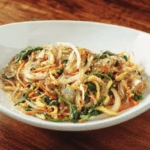
7-Ingredient Japchae with American Ingredients (30-Minute Recipe)
Ingredients
- 8 oz whole wheat spaghetti or any spaghetti
- 2 cups frozen stir-fry vegetable mix with broccoli, peppers, carrots
- 1.5 cups shredded rotisserie chicken
- 1 tbsp olive oil or neutral oil
- ¼ cup soy sauce low sodium preferred
- 2 tbsp maple syrup or honey
- 1 tbsp garlic powder
- 1 tbsp sesame seeds (Optional garnish) 2 chopped scallions
Instructions
Step 1 – Boil the Noodles
- Bring a large pot of water to a boil. Add the spaghetti and cook for 8 minutes until al dente. Drain and immediately plunge into an ice bath to stop cooking and create a chewy, japchae-like texture. Drain again and set aside.
Step 2 – Make the Japchae Sauce
- In a small bowl, whisk together ¼ cup soy sauce, 2 tbsp maple syrup, 1 tbsp garlic powder, and a pinch of black pepper. Set aside. This sweet-savory blend gives classic japchae sauce flavor without specialty ingredients.
Step 3 – Sauté the Vegetables
- Heat 1 tbsp olive oil in a large skillet over medium-high heat. Add the frozen stir-fry vegetables and cook for 4–5 minutes until tender and slightly caramelized.
Step 4 – Add the Chicken
- Stir in 1.5 cups of shredded rotisserie chicken. Sauté for 2–3 minutes until heated through. Optional: drizzle with 1 tsp soy sauce for extra flavor.
Step 5 – Combine and Stir-Fry
- Add the drained noodles and the japchae sauce to the skillet. Using tongs, gently toss everything together for 3–4 minutes, until the noodles are glossy and evenly coated.
Step 6 – Garnish and Serve
- Remove from heat. Sprinkle with sesame seeds and chopped scallions. Serve warm—or enjoy chilled for a cold japchae-style noodle salad!
Notes
- Vegan Option: Swap chicken for tofu and use coconut aminos instead of soy sauce.
- Low-Sugar Hack: Cut maple syrup to 1 tbsp and balance with a dash of rice vinegar.
- Texture Tip: The ice bath is essential! It prevents mushy noodles and mimics the chew of authentic japchae noodles.
- Protein Swap: Try ground beef or sliced mushrooms for a vegetarian take.
- Storage: Keeps well for 3 days in the fridge—great for meal prep or next-day lunch.
